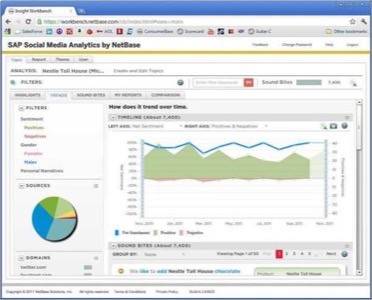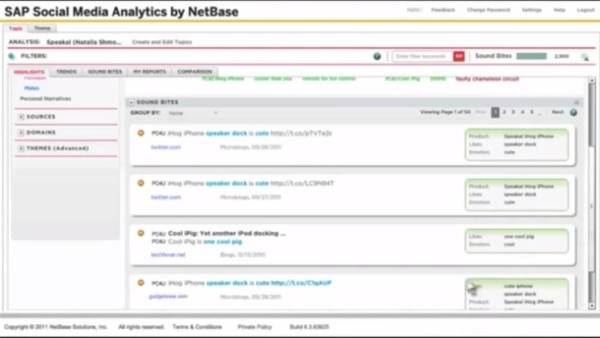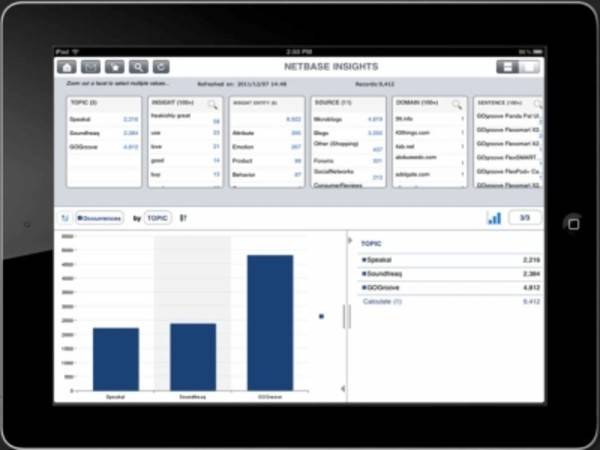In a New York Times interview published yesterday, Salesforce.com CEO Marc Benioff – who was no doubt relishing his place in the spotlight – poked a little fun at his competitors, whom he now perceives as challengers to his position. “Where are SAP, Microsoft, Oracle?” Benioff asked. “Why haven’t they taken our customers?”

Well, Mr. Benioff might want to look over his shoulder. SAP, which still touts itself as the world’s largest provider of business software, is entering one of Salesforce’s prize markets in a very big way this morning: with a live social media analytics tool that leverages an existing mother lode of data on consumer sentiment from market research firm NetBase. The objective is to enable manufacturers and service providers to get live analysis of consumer sentiment about the services and products they offer, based on what they’re tweeting to Twitter and Facebook.
SAP Social Media Analytics, whose availability is slated for “early next year,” will be a cloud-based tool that includes the last 12 months of NetBase data, with sentiment analysis already having been processed. So any new trends that come in (and they will, up-to-the-minute) will be live supplements.

“Think about a 30-terabyte database that is populated with all kinds of social media posts – Twitter feeds; Facebook comments; blogs like Huffington Post, Gizmodo; news site feeds like MSNBC.com, NYTimes.com; GlobeAndMail.com – and we refresh this environment with 95 million postings every single day,” explains Byron Barnes, SAP’s vice president for business analytics solutions marketing, in an interview with ReadWriteWeb. “And the environment contains about a year of information. It’s all been normalized, it’s already categorized by topics, brands, vendors, areas of interest. And we also provide the [customer] with a set of dashboards and metrics so they can come in through a browser and have immediate access to a year’s worth of social media data, to start to understand, what are the trends? What are [consumers] talking about? What things do they like?”
NetBase tells RWW it’s already scouring the world’s forums and comments sections (probably including ours) in search of the context in which consumers tend to mention brand names. And by running sophisticated linguistic analysis (not just written language, but also Twitter-ese), the firm has already drawn conclusions about consumer sentiments, extrapolating demographic breakdowns by comparing the comments and expressions we make every day against the personal data we’ve already provided to social network hubs like Facebook.

“It’s more than just tweets. Where it gets really interesting, and where I think the more actionable insight comes from, are places like forums,” explains Lisa Joy Rosner, NetBase’s chief marketing officer. She cites the example of beer drinkers, who peruse forums on the subjects of brewing and microbreweries, sharing their insights about grains, recipes, sugars, agriculture, and distilling equipment. NetBase has already drilled down to this level. Scrapbook hobbyists are another example: They like to share comments about various grades of paper, and grades of adhesives that don’t organically degrade their precious keepsakes over years of storage. “The really juicy insights come from forums, blogs, comments, ratings, and reviews.”
People’s new-found habit of commenting online on what they’re doing naturally extends to what they’re consuming, Rosner goes on. She calls this habit “Twitter Tourette’s:” for instance, enough folks out there who just happen to be drinking Diet Coke or eating Snickers will tweet that little fact. It’s a big enough sample of people to make analytical conclusions – certainly bigger than the number of people gathered by a soft drink producer for focus groups.
The official name for this analysis process is not “Twitter Tourette’s” but rather occasion-based marketing. One NetBase customer, Rosner tells us, can view into Twitter data by time of day to determine when they are interacting with their products. (Imagine a wave of Snickers eating activity passing over the Earth like nightfall.) That customer can then determine the best times of day to e-mail coupons to their customers; if they can catch just the right half-hour block, they can maximize these coupons’ usage. “There are different types of insights that come out of these different channels for this chatter,” she says.
How much of this data is that trustworthy? Let’s face it, a great number of tweets are automatic. And many are more full of hashtags than they are verbiage. Simply because something is retweeted does not necessarily mean something was said.
As NetBase’s vice president for business development, Fred Mondragon, tells RWW, those contingencies were already considered.
“We identify duplicate tweets, so if somebody keeps tweeting the same thing a lot, we can exclude or include that as part of your analysis,” Mondragon explains. “One of the big differentiators between our system and others is that it provides an automatic aggregation of different sentiments, likes, dislikes, emotions, and behaviors. And you’ll quickly see if somebody is trying to game the system, because you can identify the duplicates really quickly, eliminate spam. Though spamming can happen in Twitter, most of what we find [there] is people expressing emotions, behaviors, very succinctly.”
NetBase’s language filtering mechanism was developed and is overseen, we were told, by nine Ph.Ds in computational linguistics. Emoticons, intentional misspellings, abbreviations (one of Rosner’s favorites being “kewl”), and other roadblocks to typical natural language processing engines, “are handled very elegantly with this special-purpose-built NLP engine that runs in the cloud to handle social media,” remarks Mondragon.

Byron Banks tells us that Social Media Analytics will be marketed and sold as a browser-based tool (including for iPad), and on a subscription basis by SAP, using an SAP contract. Users who access the subscription server and the social intelligence database, they’ll be directed to the NetBase environment specially geared for the product.










